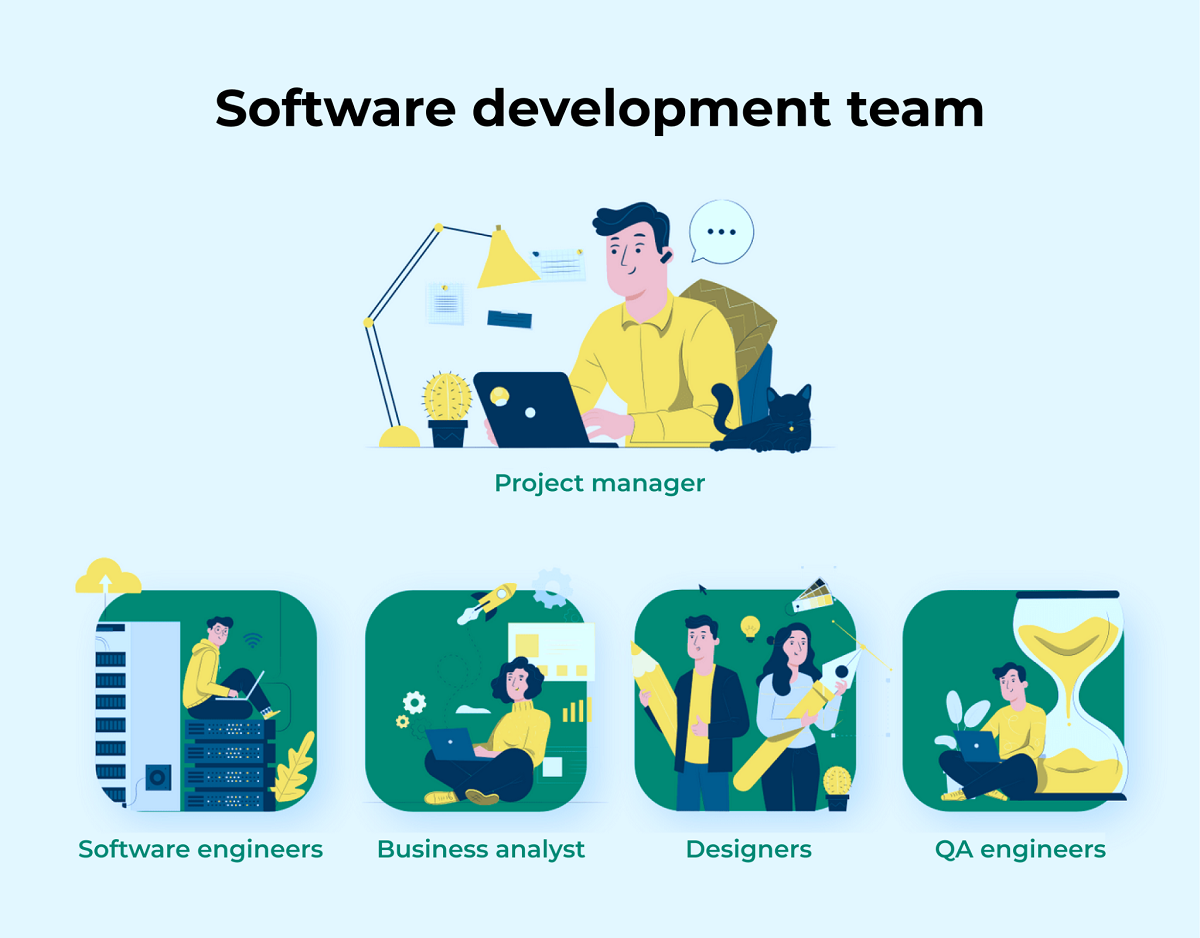Developing an App for Your Business: Choosing the Right Niche and Features
Nowadays more and more up-to-date projects release applications for business evolvement. Such apps can significantly scale it, provide extra benefits, discover new opportunities, and even become a separate income resource. Statista states that the mobile app market is expected to surmount $940 billion in 2023.
Building an app is quite a complex task comprising its peculiarities. This article will cover defining your business field, what features to include, and how to estimate the business app development cost.
Defining Product Requirements
The full-cycle product development includes the involvement of multiple teammates who make a project of your application together.
Here are the details of each development step:
1#Plan
This step requires the work of business analysts, who make a rough estimate of your project and clarify the requirements for the final product. There’s no point in being laconic, so you should thoroughly explain the functional, design, interface elements, and other details you’ll be asked for. After that, the team proceeds to the planning phase. Business analysts write specifications for engineers using your requirements. UI/UX designers build wireframes for your confirmation.
2#Design
A sophisticated design with an intuitive interface and easy-to-use is not a simple task. Each part, section, and screen of an app should be well-thought-out and properly placed. The number of designers to hire depends on the app’s complexity. The app’s color palette and fonts, and other style aspects should make the user experience convenient.
An example: Dribbble is a widely used platform to find IT providers with excellent UI/UX design services and check their portfolio.
3#Development flow
Depending on the chosen platform and field, software engineers use a certain solution stack to build an application. To illustrate, an e-Commerce iOS application requires Swift knowledge. So note that to hire app developer who is competent and experienced in working with required languages.
4#Quality Assurance
Other integral teammates are QA engineers. They test the product to detect bugs and fix them. Issues with an app operation may lead not only to usage disadvantages but to data security problems. So it is better to overcome all the challenges before launching an app than to suffer from headaches and deter the consumers after releasing.
So now, we’ve briefly covered the development flow stages. However, there are many other details to think about in practice, such as choosing the platform and development methods.
Native apps
In a nutshell, a native app is built separately for each platform with the help of suitable programming languages.
The main benefit of this method is the seamless work and the accessibility to all the native device features. GPS or image processing causes a high workload which may operate efficiently with CPU, GPU, and RAM resources. Native app development allows a proper resource distribution to achieve fast operation.
Nevertheless, there is another way to develop an app for two platforms simultaneously and save time-to-market.
Cross-Platform apps
The cross-platform development flow differs from the native’s. First, the native code is needed to manage the user interface. React Native or PhoneGap are used to build the base part. Finally, two components are assembled for a successful operation.
The primary disadvantage of this approach is a frames-per-second loss caused by converting one language to another.
Flutter is a platform that solves this challenge by offering 60 FPS and using Dart. In addition, building a design on Flutter also eases the process. Its main idea is to allow adjusting all the design components to achieve maximum flexibility and satisfy every user’s individual needs, preferences, and tastes.
Hybrid apps are worth mentioning too: they present the interface in a web version and require the download like native ones. The building time is shorter in half, but the number of inadaptive features is insufficient in the context of modernity.
How to select?
The most suitable option may be indicated after defining your product requirements. If you have limited time and financial resources, you should go for cross-platform or hybrid app development. In case you would like to create a complex app with a brilliant design and a smooth performance, you should choose the native approach.
Let’s compare those three options to ease the choosing process:
| Elements | Native | Cross-platform | Hybrid |
| Cost | Most costly (2 platforms) | Almost two times cheaper in comparison with native development | |
| Operation | Excellent; seamless | Decreased due to API transmits | web version in inconvenient with poor functional |
| Features | Native device features are available | Oblique connection to the device’s hardware causes the inaccessibility of some features | |
| Interface | The interface allows the implementation of every idea | Flutter enables adjusting the app | Only helpful for content display |
| Code reusability | Only suitable for one platform | Suitable for both platforms | |
| Updates | The cost depends on the platform | Consists of the cost for the update for two platforms |
Certain Niche App Requirements
Each field has certain peculiarities and requirements from an app to meet the business aims.
Consequently, the solution stack also varies. You may check possible tech stacks for apps of various niches.
Food Delivery
It’s a brilliant way to scale a restaurant or cafe business. A must-have service to integrate is geolocation which enables ordering with the help of online maps. To save outgoings, the app may comprise the field where users type their addresses for couriers. Geolocation is more costly, but it allows tracking the order on the map.
The essential features of this type of app are listed below:
- Registration
- Menu
- Chat
- Geolocation
- Order list
- Checkout
Optional technical stack:
E-Commerce
Online shopping is a sought-after industry nowadays. Sellers and purchasers actively use such apps to connect to each other and arrange a deal.
MVP features for it are the following:
- Registration/Authorization
- Homepage
- Catalog
- Product page
- Shopping cart
- Payment gateway
- Technical support
Approximate tech stack:
Healthcare
Telemedicine services allow conducting doctor appointments online and solve health-related issues remotely. Therapists may operate prescriptions, track patients’ health conditions and the curing process, etc.
Telehealth apps’ MVP is similar to previous business platforms, so here’s the essential feature list:
- Registration
- Managing EHRs
- Search for physicians
- Videocall
- Chat
- Managing appointments
- Payment gateway
- Reviews
- Notifications
It’s significant to mention that such apps manage electronic health records. Therefore, they obey HIPAA regulations which should be obligatorily followed.
Possible tech stack:
Streaming
This amusement is demanded by millennials. Statista’s analysis indicates that about 80% of young people in the US have a streaming service subscription. It’s a way for influencers to interact and communicate with their followers. The main monetization models are paid subscriptions and ads.
Here are the must-have features for a business app for streaming
- Registration
- Profile
- Streaming
- Comments section
- Search
Potential tech stack:
E-Learning
Coursera and Udemy are big market players which have evolved the e-Learning industry. They provide learners with qualitative materials from top-notch educational establishments. That’s why Coursera’s market value is over $1 billion.
MVP features of successful e-Learning app include:
- Authentication
- Profile
- Filtering
- Dashboard
- Course page
- Payment methods
- Course uploading (for tutors)
- Notifications
- Admin panel
Required solution stack:
Choosing a Hiring Option
After exploring the development methods, we may proceed to hire options and overview:
- Outsourcing company
- In-house development
- Freelance developer
Let’s review each option in detail.
Outsourcing company
Such companies offer taking over all the project development responsibilities at a most beneficial value for money. Parallelly to the high cost-effectiveness (in comparison to in-house), outsourcing companies deliver high-quality performance, an outstanding customer experience, and efficient products. Reasonable rates and no need to rent an office for the team ease the project developing process.
The most efficient way to choose the most experienced and competent outsourcing vendor is to visit Clutch or Goodfirms. These platforms provide the verified rates and reviews of development companies. The cost varies due to the location:
| Region | Hourly rates ($) |
| North America | $150-$200 |
| Western Europe | $50-$149 |
| Eastern Europe | $25-$49 |
| Asia | $20-$40 |
| South America | $25-$49 |
In-House Team
Such a team comprises all the essential specialists employed and gathered by you in your enterprise’s office. This option is beneficial for major companies since you are allowed to control all the company’s processes. What’s more, it enables you to efficiently update and maintain the current projects.
Nonetheless, this option is not profitable for you in case the budget is tight. To hire the three developers, a UI/UX designer, and a QA engineer, you will need approximately $400,000 annually. Add to this sum extra expenditures like software and hardware, rent, etc.
Freelance Developers
This last option has the lowest cost. That concludes the benefits of hiring freelancers.
The reason is that there is no opportunity to manage the development process. Consequently, there’s no quality and deadlines guarantee, as well as no guarantee that the product will be delivered at all since freelancers commonly request a prepayment.
Summarize
An application is a really efficient way to scale your business. The niche and target audience defines its platform and development approach. Regardless of the chosen creation method, you should be picky when hiring specialists to receive a qualitative product that will come in handy to your current clients and attract new ones. Check the above-mentioned sources to choose a vendor for a successful and beneficial long-term cooperation.
Author’s bio:
Vitaly Kuprenko is a technical writer at Cleveroad, a web and mobile app development company in Ukraine. He enjoys writing about tech innovations and digital ways to boost businesses.




